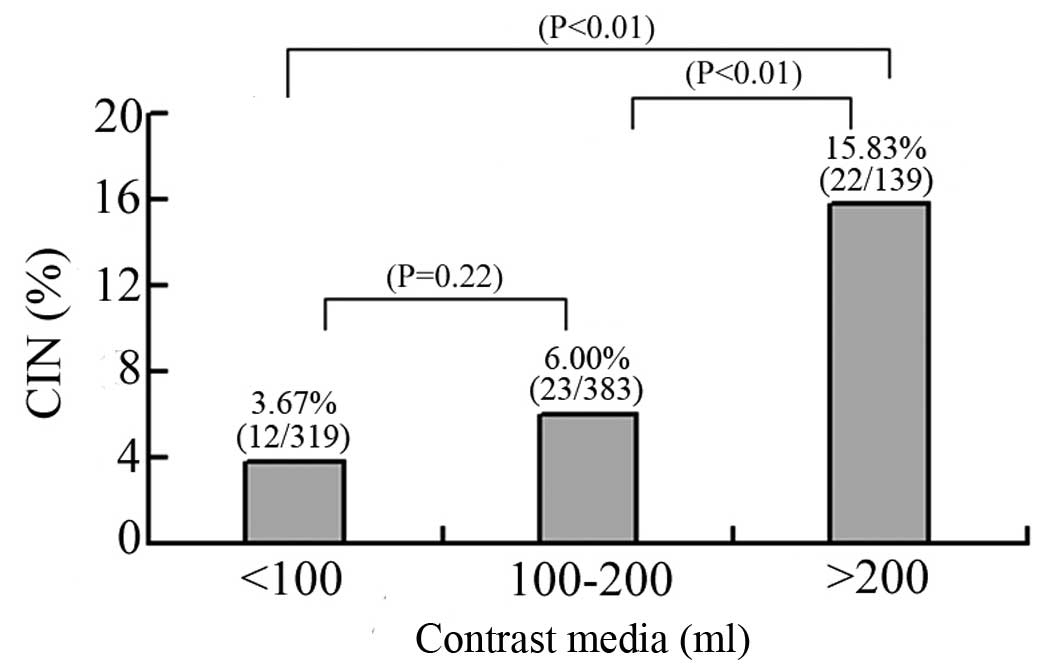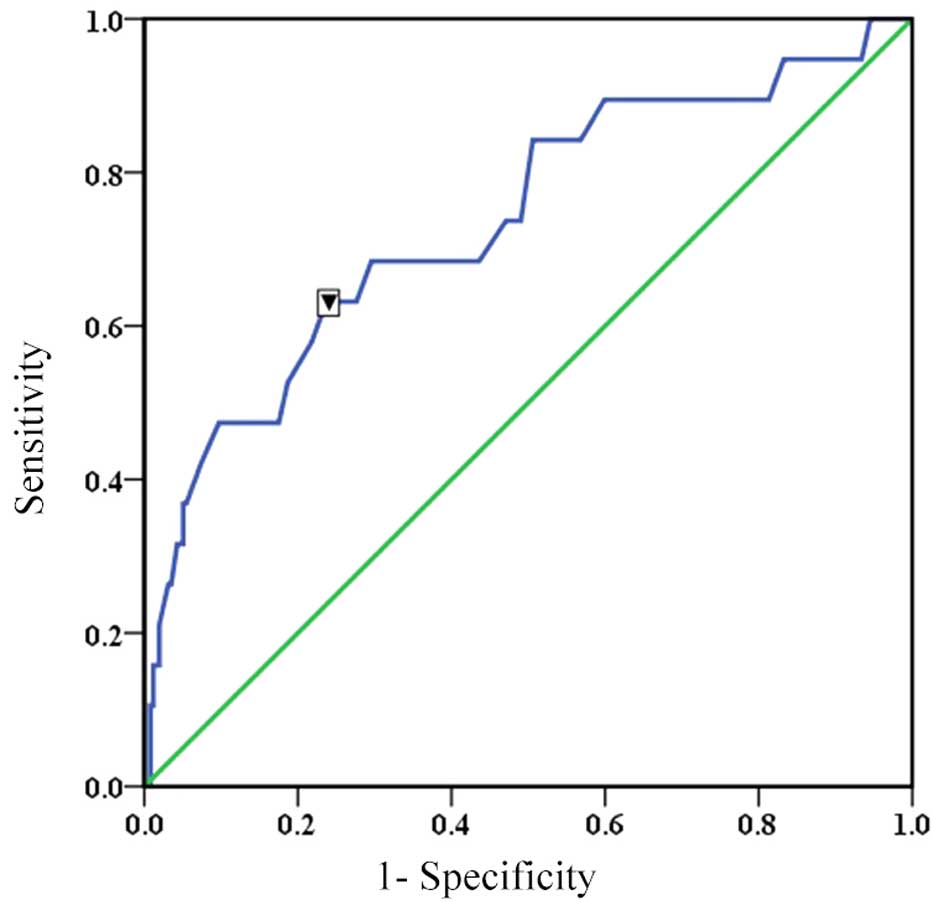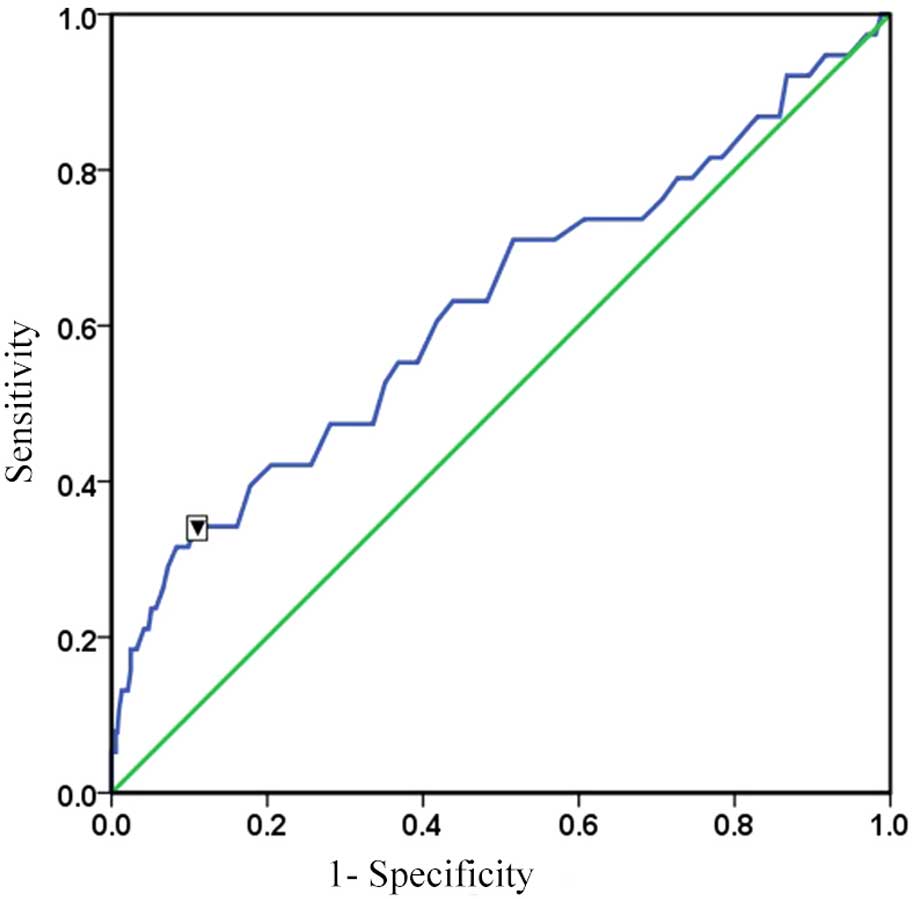|
1
|
Parfrey P, Griffiths S, Barrett B, Paul
MD, Genge M, Withers J, Farid N and McManamon PJ: Contrast
material-induced renal failure in patients with diabetes mellitus,
renal insufficiency or both: A prospective controlled study. N Engl
J Med. 320:143–149. 1989. View Article : Google Scholar : PubMed/NCBI
|
|
2
|
Gandhi S, Mosleh W, Abdel-Qadir H and
Farkouh ME: Statins and contrast-induced acute kidney injury with
coronary angiography. Am J Med. 127:987–1000. 2014. View Article : Google Scholar : PubMed/NCBI
|
|
3
|
Chertow GM, Christiansen CL, Cleary PD,
Munro C and Lazarus JM: Prognostic stratification in critically ill
patients with acute renal failure requiring dialysis. Arch Intern
Med. 155:1505–1511. 1995. View Article : Google Scholar : PubMed/NCBI
|
|
4
|
Rihal CS, Textor SC, Grill DE, Berger PB,
Ting HH, Best PJ, Singh M, Bell MR, Barsness GW, Mathew V, et al:
Incidence and prognostic importance of acute renal failure after
percutaneous coronary intervention. Circulation. 105:2259–2264.
2002. View Article : Google Scholar : PubMed/NCBI
|
|
5
|
Palli E, Makris D, Papanikolaou J,
Garoufalis G and Zakynthinos E: Contrast-induced nephropathy in
aged critically ill patients. Oxid Med Cell Longev.
2014:7564692014. View Article : Google Scholar : PubMed/NCBI
|
|
6
|
Kwasa EA, Vinayak S and Armstrong R: The
role of inflammation in contrast-induced nephropathy. Br J Radiol.
87:201307382014. View Article : Google Scholar : PubMed/NCBI
|
|
7
|
Pucelikova T, Dangas G and Mehran R:
Contrast-induced nephropathy. Catheter Cardiovasc Interv. 71:62–72.
2008. View Article : Google Scholar : PubMed/NCBI
|
|
8
|
Toprak O, Cirit M, Yesil M, Bayata S,
Tanrisev M, Varol U, Ersoy R and Esi E: Impact of diabetic and
pre-diabetic state on development of contrast-induced nephropathy
in patients with chronic kidney disease. Nephrol Dial Transplant.
22:819–826. 2007. View Article : Google Scholar : PubMed/NCBI
|
|
9
|
Mehran R and Nikolsky E: Contrast-induced
nephropathy: Definition, epidemiology, and patients at risk. Kidney
Int Suppl. 69:S11–S15. 2006. View Article : Google Scholar
|
|
10
|
Lee J, Cho JY, Lee HJ, Jeong YY, Kim CK,
Park BK, Sung DJ, Kang BC, Jung SI, Lee EJ, et al: Korean Society
of Urogenital Radiology (KSUR); Korean Society of Radiology:
Contrast-induced nephropathy in patients undergoing intravenous
contrast-enhanced computed tomography in Korea: A
multi-institutional study in 101487 patients. Korean J Radiol.
15:456–463. 2014. View Article : Google Scholar : PubMed/NCBI
|
|
11
|
Nikolsky E, Mehran R, Lasic Z, Mintz GS,
Lansky AJ, Na Y, Pocock S, Negoita M, Moussa I, Stone GW, et al:
Low hematocrit predicts contrast-induced nephropathy after
percutaneous coronary interventions. Kidney Int. 67:706–713. 2005.
View Article : Google Scholar : PubMed/NCBI
|
|
12
|
Celsing F, Svedenhag J, Pihlstedt P and
Ekblom B: Effects of anaemia and stepwise-induced polycythaemia on
maximal aerobic power in individuals with high and low haemoglobin
concentrations. Acta Physiol Scand. 129:47–54. 1987. View Article : Google Scholar : PubMed/NCBI
|
|
13
|
Kim SJ, Salem MR, Joseph NJ, Madayag MA,
Cavallino RP and Crystal GJ: Contrast media adversely affect
oxyhemoglobin dissociation. Anesth Analg. 71:73–76. 1990.
View Article : Google Scholar : PubMed/NCBI
|
|
14
|
Heyman SN, Evans RG, Rosen S and
Rosenberger C: Cellular adaptive changes in AKI: Mitigating renal
hypoxic injury. Nephrol Dial Transplant. 27:1721–1728. 2012.
View Article : Google Scholar : PubMed/NCBI
|
|
15
|
Cigarroa RG, Lange RA, Williams RH and
Hillis LD: Dosing of contrast material to prevent contrast
nephropathy in patients with renal disease. Am J Med. 86:649–652.
1989. View Article : Google Scholar : PubMed/NCBI
|
|
16
|
Task Force on the management of ST-segment
elevation acute myocardial infarction of the European Society of
Cardiology (ESC). Steg PG, James SK, Atar D, Badano LP,
Blömstrom-Lundqvist C, Borger MA, Di Mario C, Dickstein K, Ducrocq
G, Fernandez-Aviles F, et al: ESC Guidelines for the management of
acute myocardial infarction in patients presenting with ST-segment
elevation. Eur Heart J. 33:2569–619. 2012. View Article : Google Scholar : PubMed/NCBI
|
|
17
|
Hamm CW, Bassand JP, Agewall S, Bax J,
Boersma E, Bueno H, Caso P, Dudek D, Gielen S, Huber K, et al: ESC
Committee for Practice Guidelines: ESC Guidelines for the
management of acute coronary syndromes in patients presenting
without persistent ST-segment elevation: The Task Force for the
management of acute coronary syndromes (ACS) in patients presenting
without persistent ST-segment elevation of the European Society of
Cardiology (ESC). Eur Heart J. 32:2999–3054. 2011. View Article : Google Scholar : PubMed/NCBI
|
|
18
|
Liu LS: Writing Group of 2010 Chinese
Guidelines for the Management of Hypertension: 2010 Chinese
guidelines for the management of hypertension. Zhonghua Xin Xue
Guan Bing Za Zhi. 39:579–615. 2011.(In Chinese). PubMed/NCBI
|
|
19
|
Chinese Diabetes Society: 2010 Chinese
Guidelines for the Management of Diabetes. Zhonghua Xin Xue Guan
Bing Za Zhi. 20:S1–S36. 2012.(In Chinese).
|
|
20
|
Ruilope LM, Salvetti A, Jamerson K,
Hansson L, Warnold I, Wedel H and Zanchetti A: Renal function and
intensive lowering of blood pressure in hypertensive participants
of the hypertension optimal treatment (HOT) study. J Am Soc
Nephrol. 12:218–225. 2001.PubMed/NCBI
|
|
21
|
Guo J, Zheng C, Xiao Q, Gong S, Zhao Q,
Wang L, He J, Yang W, Shi X, Sun X and Liu J: Impact of anaemia on
lung function and exercise capacity in patients with stable severe
chronic obstructive pulmonary disease. BMJ Open. 5:e0082952015.
View Article : Google Scholar : PubMed/NCBI
|
|
22
|
Chinese Society of Cardiology; Editorial
Committee of Chinese Journal of Cardiology: Chinese expert
consensus on the clinical application of iodinated contrast media
in cardiovascular diseases. Zhonghua Xin Xue Guan Bing Za Zhi.
41:94–98. 2013.(In Chinese). PubMed/NCBI
|
|
23
|
Rich MW and Crecelius CA: Incidence, risk
factors, and clinical course of acute renal insufficiency after
cardiac catheterization in patients 70 years of age or older. A
prospective study. Arch Intern Med. 150:1237–1242. 1990. View Article : Google Scholar : PubMed/NCBI
|
|
24
|
Kini AS, Mitre CA, Kim M, Kamran M, Reich
D and Sharma SK: A protocol for prevention of radiographic contrast
nephropathy during percutaneous coronary intervention: Effect of
selective dopamine receptor agonist fenoldopam. Catheter Cardiovasc
Interv. 55:169–173. 2002. View Article : Google Scholar : PubMed/NCBI
|
|
25
|
Solomon R: The role of osmolality in the
incidence of contrast-induced nephropathy: A systematic review of
angiographic contrast media in high risk patients. Kidney Int.
68:2256–2263. 2005. View Article : Google Scholar : PubMed/NCBI
|
|
26
|
Barrett BJ and Carlisle EJ: Metaanalysis
of the relative nephrotoxicity of high- and low-osmolality
iodinated contrast media. Radiology. 188:171–178. 1993. View Article : Google Scholar : PubMed/NCBI
|
|
27
|
Nozue T, Michishita I, Iwaki T, Mizuguchi
I and Miura M: Contrast medium volume to estimated glomerular
filtration rate ratio as a predictor of contrast-induced
nephropathy developing after elective percutaneous coronary
intervention. J Cardiol. 54:214–220. 2009. View Article : Google Scholar : PubMed/NCBI
|
|
28
|
Goldenberg I and Matetzky S: Nephropathy
induced by contrast media: Pathogenesis, risk factors and
preventive strategies. CMAJ. 172:1461–1471. 2005. View Article : Google Scholar : PubMed/NCBI
|
|
29
|
Chinese society of cardiology, Editorial
committee of Chinese journal of cardiology: Chinese expert
consensus on the clinical application of iodinated contrast media
in cardiovascular diseases. Chinese Journal of Cardiology.
41:94–98. 2013.PubMed/NCBI
|
|
30
|
Alamartine E, Phayphet M, Thibaudin D,
Barral FG and Veyret C: Contrast medium-induced acute renal failure
and cholesterol embolism after radiological procedures: Incidence,
risk factors, and compliance with recommendations. Eur J Intern
Med. 14:426–431. 2003. View Article : Google Scholar : PubMed/NCBI
|
|
31
|
Ho KM and Power BM: Benefits and risks of
furosemide in acute kidney injury. Anaesthesia. 65:283–293. 2010.
View Article : Google Scholar : PubMed/NCBI
|
|
32
|
Gu GQ, Lu R, Cui W, Liu F, Zhang Y, Yang
XH, Chen XF and Jia WM: Low-dose furosemide administered with
adequate hydration reduces contrast-induced nephropathy in patients
undergoing coronary angiography. Cardiology. 125:69–73. 2013.
View Article : Google Scholar : PubMed/NCBI
|
|
33
|
Toprak O and Cirit M: Risk factors for
contrast-induced nephropathy. Kidney Blood Press Res. 29:84–93.
2006. View Article : Google Scholar : PubMed/NCBI
|
|
34
|
Toprak O, Cirit M, Yesil M, Byrne DW,
Postaci N, Bayata S, Majchrzak KM and Esi E: Metabolic syndrome as
a risk factor for contrast-induced nephropathy in non-diabetic
elderly patients with renal impairment. Kidney Blood Press Res.
29:2–9. 2006. View Article : Google Scholar : PubMed/NCBI
|
|
35
|
Liu Y, Tan N, Zhou YL, He PC, Luo JF and
Chen JY: The contrast medium volume to estimated glomerular
filtration rate ratio as a predictor of contrast-induced
nephropathy after primary percutaneous coronary intervention. Int
Urol Nephrol. 44:221–229. 2012. View Article : Google Scholar : PubMed/NCBI
|
|
36
|
Macciò A, Madeddu C, Gramignano G, Mulas
C, Tanca L, Cherchi MC, Floris C, Omoto I, Barracca A and Ganz T:
The role of inflammation, iron, and nutritional status in
cancer-related anemia: Results of a large, prospective,
observational study. Haematologica. 100:124–132. 2015. View Article : Google Scholar : PubMed/NCBI
|
|
37
|
Weiss G and Goodnough LT: Anemia of
chronic disease. N Engl J Med. 352:1011–1023. 2005. View Article : Google Scholar : PubMed/NCBI
|
|
38
|
Waters JS, O'Brien ME and Ashley S:
Management of anemia in patients receiving chemotherapy. J Clin
Oncol. 20:601–603. 2002.PubMed/NCBI
|
|
39
|
Hsu CY, McCulloch CE and Curhan GC:
Epidemiology of anemia associated with chronic renal insufficiency
among adults in the United States: Results from the Third National
Health and Nutrition Examination Survey. J Am Soc Nephrol.
13:504–510. 2002.PubMed/NCBI
|
|
40
|
Nurko S: Anemia in chronic kidney disease:
Causes, diagnosis, treatment. Cleve Clin J Med. 73:289–297. 2006.
View Article : Google Scholar : PubMed/NCBI
|
|
41
|
Astor BC, Coresh J, Heiss G, Pettitt D and
Sarnak MJ: Kidney function and anemia as risk factors for coronary
heart disease and mortality: The Atherosclerosis Risk in
Communities (ARIC) Study. Am Heart J. 151:492–500. 2006. View Article : Google Scholar : PubMed/NCBI
|
|
42
|
Shah AD, Nicholas O, Timmis AD, Feder G,
Abrams KR, Chen R, Hingorani AD and Hemingway H: Threshold
haemoglobin levels and the prognosis of stable coronary disease:
Two new cohorts and a systematic review and meta-analysis. PLoS
Med. 8:e10004392011. View Article : Google Scholar : PubMed/NCBI
|
|
43
|
Carson JL, Noveck H, Berlin JA and Gould
SA: Mortality and morbidity in patients with very low postoperative
Hb levels who decline blood transfusion. Transfusion. 42:812–818.
2002. View Article : Google Scholar : PubMed/NCBI
|
|
44
|
Barbarova I, Klempfner R, Rapoport A,
Wasserstrum Y, Goren I, Kats A and Segal G: Avoidance of Blood
Transfusion to Patients Suffering From Myocardial Injury and Severe
Anemia Is Associated With Increased Long-Term Mortality: A
Retrospective Cohort Analysis. Medicine (Baltimore). 29:e16352015.
View Article : Google Scholar
|
|
45
|
Klein MJ, Carter TI, Smith MC, Wong J and
Sugiyama G: Prophylactic hypothermia and neuromuscular blockade to
limit myocardial oxygen demand in a critically anemic Jehovah's
Witness after emergency surgery. J Surg Case Rep. 12:rju1352014.
View Article : Google Scholar
|
|
46
|
McCullough PA and Sandberg KR:
Epidemiology of contrast-induced nephropathy. Rev Cardiovasc Med.
4(Suppl 5): S3–S9. 2003.
|
|
47
|
World Health Organization: Haemoglobin
concentrations for the diagnosis of anaemia and assessment of
severity. Vitamin and Mineral Nutrition Information System. WHO.
(Geneva). 1–6. 2011.
|

















